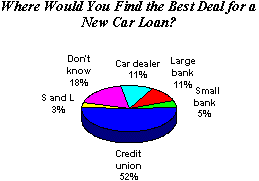![]()
Arizonans Believe They Get Best Interest Rates From Credit Unions
Arizonans are almost five times as likely to expect to get the best deal when shopping for a new car loan from a local credit union rather than from a bank or other type of financial institution This is just one of the findings of the most recent, special banking edition of the O’Neil Associates Valley Monitor Poll, which asked 511 adults throughout Arizona the following question:
If you were to go shopping for a new-car loan, do you think you would get the best deal from a large bank, a small bank, a credit union, a savings and loan, or the car dealer?

According to the responses we received to this question, roughly one half (52%) of the adults statewide believes that credit unions generally offer the "best deals" on car loans. This share is markedly higher than the share claimed by banks, with only eleven percent of the respondents believing that large banks offer the best deal with another five percent believing that small banks are the best bet. Car dealers, in fact, are deemed just as attractive for new car loans as are large banks, with the dealers accounting for another eleven percent of the respondents. With only three percent selecting savings and loans, that leaves nearly one fifth (18%) who said they were unable to single out any of these institutions as offering the best deals on new car loans.
We also asked this same group of respondents to name the type of financial institution from which they would expect to find the best deals on general home-improvement loans; once again, credit unions came out on top. Credit unions’ advantage in this area is not quite as large as it is regarding new car loans. Specifically, only a plurality (42%) selected credit unions as the best place to shop for home-improvement loan, but this figure is still twice as large a share as that enjoyed by the second-place institution—large banks at 21 percent. Again, only a small fraction (6%) of Arizonans believe that small banks are the places to find the best loan deals, a fraction that is smaller than even the share of respondents choosing savings and loans (8%). That once again leaves a sizable minority (23%) who said they did not know if any of these institutions tended to offer better deals than those offered by the others.
Credit Unions Most Popular Outside Phoenix and Tucson
Our crosstabular analysis did not reveal any dramatic variation between subgroups in terms of their opinions regarding the best places to shop for personal loans. In other words, credit unions are the preferred choice for car and home-improvement loans among all of the groups we examined. That said, two groups did stand out as being particularly fond of credit unions: people who live outside Phoenix and Tucson, and high-income households.
Outside Phoenix and Tucson: Residents of Arizona counties other than Maricopa and Pima are more likely than their metropolitan counterparts to single out credit unions as the best place to get a personal loan. Fully 58 percent of these residents from "other counties" believe credit unions offer the best deals for car loans, and 51 percent believe they offer the best deal on home-improvement loans. These figures compare to equivalent results of 51 percent and 39 percent among Maricopa County residents and 49 percent and 36 percent among Pima County residents—the state’s two largest metropolitan areas where banks are relatively more popular than elsewhere in the state.
High-Income Households: We found a consistent, positive relationship between respondents’ annual incomes and their likelihood of choosing credit unions as the institutions offering the best deals on personal loans. For example, fully 60 percent of the respondents with annual incomes over $40,000 said credit unions offer the best deals on new car loans, compared to only 38 percent of the respondents with incomes under $25,000 per year. The gap between these two groups’ responses regarding credit unions as a place to get home-improvement loans is almost as large: 44 percent for the high-income group, 26 for the low-income group.
These results are based on 459 interviews conducted with randomly selected heads of household in metropolitan Phoenix. The "sampling error" associated with a survey of this size is approximately ±4.6 percent. This means that the chances are approximately 95 in 100 that we would have obtained the same results, within a margin of ±4.6%, had we interviewed every adult resident of Maricopa County.